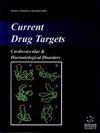脑再生中的转录因子:潜在的新治疗靶点
IF 3
4区 医学
Q2 PHARMACOLOGY & PHARMACY
引用次数: 0
摘要
:转录因子在为每个细胞群提供特性方面发挥着至关重要的作用。要保持细胞特性,必须平衡激活转录因子和抑制转录因子的表达。细胞可塑性和重编程为未来的治疗应用提供了巨大潜力,因为它们可以再生受损组织。特定的利基因子可以改变基因表达,使目标细胞分化或转分化为所需的命运。神经干细胞(NSC)具有表观基因组和转录组记忆,因此被认为是生成新神经元的首选细胞。NEUROD1/ASCL1、BRN2、MYTL1和其他转录因子可诱导成纤维细胞等体细胞直接重编程为神经元。然而,转录因子在重编程和分化过程中的分子生物学作用仍有待全面了解。本文章由计算机程序翻译,如有差异,请以英文原文为准。
Transcription Factors in Brain Regeneration: A Potential Novel Therapeutic Target
: Transcription factors play a crucial role in providing identity to each cell population. To maintain cell identity, it is essential to balance the expression of activator and inhibitor transcription factors. Cell plasticity and reprogramming offer great potential for future therapeutic applications, as they can regenerate damaged tissue. Specific niche factors can modify gene expression and differentiate or transdifferentiate the target cell to the required fate. Ongoing research is being carried out on the possibilities of transcription factors in regenerating neurons, with neural stem cells (NSCs) being considered the preferred cells for generating new neurons due to their epigenomic and transcriptome memory. NEUROD1/ASCL1, BRN2, MYTL1, and other transcription factors can induce direct reprogramming of somatic cells, such as fibroblasts, into neurons. However, the molecular biology of transcription factors in reprogramming and differentiation still needs to be fully understood.
求助全文
通过发布文献求助,成功后即可免费获取论文全文。
去求助
来源期刊

Current drug targets
医学-药学
CiteScore
6.20
自引率
0.00%
发文量
127
审稿时长
3-8 weeks
期刊介绍:
Current Drug Targets aims to cover the latest and most outstanding developments on the medicinal chemistry and pharmacology of molecular drug targets e.g. disease specific proteins, receptors, enzymes, genes.
Current Drug Targets publishes guest edited thematic issues written by leaders in the field covering a range of current topics of drug targets. The journal also accepts for publication mini- & full-length review articles and drug clinical trial studies.
As the discovery, identification, characterization and validation of novel human drug targets for drug discovery continues to grow; this journal is essential reading for all pharmaceutical scientists involved in drug discovery and development.
 求助内容:
求助内容: 应助结果提醒方式:
应助结果提醒方式:


